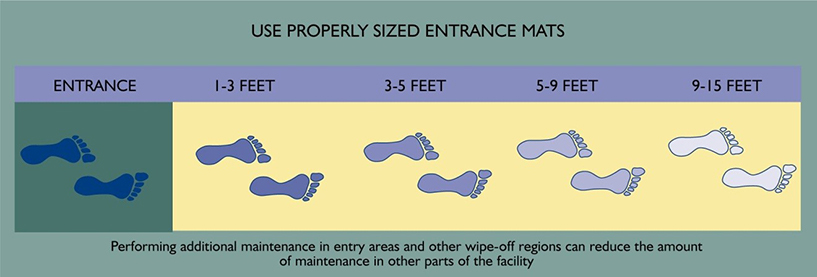Preventive measures consist of using interior and exterior walk off systems capable of scraping, brushing, or absorbing moisture, and debris off shoes. Inside mats remove smaller particles of dirt as well as oils and other liquids that can be tracked in from outside (See Figure 1).
Outside entrance - use exterior soil-removal mats that have a coarse texture, are able to brush soil from shoes and hold large amounts of soil.
Inside interior mats (or installed walk-off tile) - use water absorbent mats to prevent tracked-in moisture from getting to the carpet. Mats that extend for 9 to 15 feet inside the entrance will trap eighty percent of soil and moisture from the first five or six steps. Using both types of mats at entrances helps prevent excessive soiling on carpet and slip/fall hazards.
Keeping parking lots, sidewalks, and entrances clean will cut down on the tracking in of debris.
Figure 1

Protective mats should be used around food/coffee stations, water coolers, printers, elevators, service entrances, and stair thresholds to prevent moisture and dirt from becoming ground into carpet.
For mats to continue to trap soil, they should be cleaned/vacuumed or replaced on a regular basis, more frequently than the carpet. If accumulated soil is not removed, the mat will become overloaded and cannot prevent soil from entering the building.
Other preventive tips include restricting food and beverage consumption to specific areas, requiring lids on drinks or oversized cups and by placing trashcans in easily accessible areas.
NOTE: It is recommended the area underneath a desk should be protected by a chair mat. (Check carpet manufacturer’s warranty for product specific information). These areas are sometimes considered low-traffic areas; however, the chair rollers can create damage due to the concentration of wear.
NOTE: During new construction or renovation, plastic carpet protectors with adhesives should not be used to cover the carpet. Self-adhering plastic films may leave residues that result in rapid soiling after removal. Do not place plastic sheeting over any carpet installation because it may present a slip hazard. Most importantly, plastic coverings will trap moisture, retard adhesive curing, and may promote mold growth.